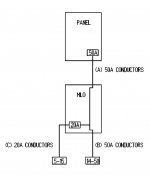- Location
- Connecticut
- Occupation
- Engineer
210.23(C)So what NEC section prohibits the circuit arrangement I described?
210.23(C)So what NEC section prohibits the circuit arrangement I described?
wasnt the cb you were referring to a "piggy back" type? or a true 2P cb?I get it now, current is constant in a circuit. So if 40 amps are going through the breaker on one leg, then 40 amps are also going through the other leg. I just had to think about it logically for a second. Did you remember to put cover sheet on the TPS report?
If both receptacles supply cooking appliances fixed in place (say an electric range and a built-in microwave), there is certainly no 210.23(C) violation.210.23(C)

Either two single 40 amp with handle tie or a common trip.wasnt the cb you were referring to a "piggy back" type? or a true 2P cb?
Great...so you have a branch circuit (A) supplying a panelboard...which violates 210.23(C).(A) and (B) are branch circuits, and (C) is not in the circuit.
210.23 says "A branch circuit supplying two or more outlets or receptacles shall supply only the loads specified according to its size as specified in 210.23(A) through (D)." In that context, "loads" means "utilization equipment," and a panelboard is not utilization equipment. So 210.23 does not prohibit it.Great...so you have a branch circuit (A) supplying a panelboard...which violates 210.23(C).
You said A is a branch circuit, and A is supplying two or more outlets. Therefore, A is not permitted to supply the panelboard, per 210.23(C).210.23 says "A branch circuit supplying two or more outlets or receptacles shall supply only the loads specified according to its size as specified in 210.23(A) through (D)." In that context, "loads" means "utilization equipment," and a panelboard is not utilization equipment. So 210.23 does not prohibit it.
A panelboard is not utilization equipment. While it supplies load, it is not a load itself. So as a non-load, 210.23 does not prohibit it being on the branch circuit.You said A is a branch circuit, and A is supplying two or more outlets. Therefore, A is not permitted to supply the panelboard, per 210.23(C).
See Article 100. From the 2017: "Equipment that utilizes electric energy for electronic, electromechanical, chemical, heating, lighting, or similar purposes."What is utilization equipment? Official nec definition?
Location and lot size.I knew inflation was bad, but 2.6 million for a 1,725 square foot house? What makes it so expensive?
Got it, I was thinking of it from an insurance perspective, how much it would cost to rebuild the house if it had an electrical fire. Not property value.Location and lot size.
Ron
I don't understand how this is controversial at all. Unless the NEC adds a rules of the form "the wiring between an outlet and the final overcurrent device for that outlet shall not supply any branch circuit overcurrent devices," that arrangement is permitted. Which per the definitions creates a wiring segment which is both a branch circuit and a feeder.Oh man we got a "can a branch circuit also be a feeder?" thread!

